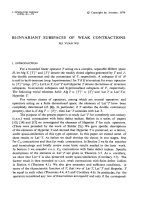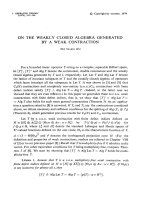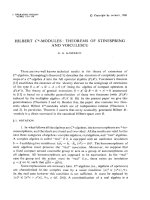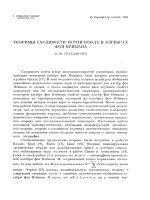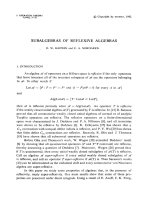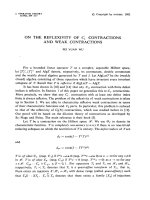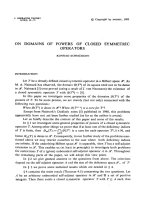Báo cáo toán học: "Closed Weak Supplemented Modules" pps
Bạn đang xem bản rút gọn của tài liệu. Xem và tải ngay bản đầy đủ của tài liệu tại đây (148.83 KB, 14 trang )
Vietnam Journal of Mathematics 34:1 (2006) 17–30
Closed Weak Supplemented Modules
*
Qingyi Zeng
1
Dept. of Math., Zhejiang University, Hangzhou 310027, China
2
Dept. of Math., Shaoguan University, Shaoguan 512005, China
Received June 13, 2004
Revised June 01, 2005
Abstract. A module M is called closed weak supplemented if for any closed submod-
ule
N of M , there is a submodule K of M such that M = K + N and K ∩ N M.
Any direct summand of a closed weak supplemented module is also closed weak supple-
mented. Any finite direct sum of lo cal distributive closed weak supplemented modules
is also closed weak supplemented. Any nonsingular homomorphic image of a closed
weak supplemented module is closed weak supplemented.
R is a closed weak supple-
mented ring if and only if
M
n
(R) is also a closed weak supplemented ring for any
positive integer
n.
1. Introduction
Throughout this paper, unless o therwise stated, all rings are associative rings
with identity and all modules ar e unitary right R-modules.
A submodule N of M is called an essential submodule, denoted by N
e
M,
if for any nonzero submodule L of M, L ∩ N = 0. A closed submodule N of M ,
denoted by N
c
M, is a submodule which has no proper essential extension in
M.IfL
c
N and N
c
M,thenL
c
M (see [2]).
A submodule N of M is small in M, denoted by N M,ifN + K = M
implies K = M .LetN and K be submodules of M. N is called a supplement of
K in M if it is minimal with respect to M = N +K,orequivalently,M = N +K
∗
This work was supported by the Natural Science Foundation of Zhejiang Province of China
Project(No.102028).
18 Qingyi Zeng
and N ∩ K N (see [6]). A module M is called supplemented if for any
submodule N of M there is a submodule K of M such that M = K + N
and N ∩ K N (see [3]). A module M is called weak supplemented if for each
submodule N of M , there is a submodule L of M such that M = N + L and
N ∩ L M . A module M is called ⊕-supplemented if every submodule N of M
has a supplement K in M which is also a direct summand of M (see [8]).
A module M is called extending, or a CS module, if every submodule is
essential in a direct summand of M, or equivalently, every closed submodule is
a direct summand (see [9]).
Let M be a module and m ∈ M.Thenr(m)={r ∈ R|mr =0} is called
right annihilator of m. First we collect some well-known facts.
Lemma 1.1. [1] Let M
be a module and let K L and L
i
(1 i n) be
submodules of M , for some positive integer n. Then the following hold.
(1) L M if and only if K M and L/K M/K;
(2) L
1
+ L
2
+ + L
n
M if and only if L
i
M (1 i n);
(3) If M
is a module and f : M → M
is a homomorphism, then f(L) M
where L M ;
(4) If L is a direc t summand of M,thenK L if and only if K M;
(5) K
1
⊕ K
2
L
1
⊕ L
2
if and only if K
i
L
i
(i =1, 2).
Lemma 1.2. Let N and L be submodules of M such that N + L has a weak
supplement H in M and N ∩ (H + L) has a weak supplement G in N.Then
H + G is a weak supplement of L in M.
Proof. Similar to the proof of 41.2 of [6].
In this paper, we define closed weak supplemented modules which generalize
weak supplemented modules.
In Sec. 2, we give the definition of a closed weak supplemented module and
show that any direct summand of a closed weak supplemented module and,
with some additional conditions, finite direct sum of closed weak supplemented
modules are also closed weak supplemented modules.
In Sec. 3, some conditions of which the homomorphic image of a closed weak
supplemented module is a closed weak supplemented module are given.
In Sec. 4, we show that S = End(F ) is closed weak supplemented if and only
if F is closed weak supplemented, where F is a free right R-mo dule. We also show
that R is a closed weak supplemented ring if and only if M
n
(R) is also a closed
weak supplemented ring for any po sitive integer n.LetR be a commutative ring
and M a finite generated faithful multiplication module. Then R is closed weak
supplemented if and only if M is closed weak supplemented.
In Sec. 5, we investigate the relations between (closed) weak supplemented
modules and supplemented modules, extending modules, etc,.
Closed Weak Supplemented Modules 19
2. Cl osed Weak Supplemented Modules
In [3], a module M is called weak supplemented if for every submodule N of M
there is a submodule K of M such that M = K + N and N ∩ K M.Also,
co-finitely weak supplemented modules have been defined and studied. Now we
give the definition of a closed weak supplemented module as follows:
Definition 2.1. AmoduleM is c a lled closed weak supplemented if for any
closed submodule N of M, there is a submodule K of M such that M = K + N
and K ∩ N M .AsubmoduleK of M is called weak supplement if it is a weak
supplement of some submodule of M.
Clearly, any weak supplemented module is closed weak supplemented and
any extending module is closed weak supplemented. Since local modules (i.e.,
the sum of all proper submodules is also a proper submodule) are hollow (i.e.,
every proper submodule is small) and hollow modules are weak supplemented,
hence closed weak supplemented. So we have the following implications:
local ⇒ hollow ⇒ weak supplemented ⇒ closed weak supplemented.
But a closed weak supplemented need not be weak supplemented, in general.
Example 2.2. Let Z be the ring of all integers. Then Z is uniform as a Z-module
and the summands of Z are 0 and Z itself. Since all closed s ubmodules are 0
and Z, it is easy to see that Z is closed weak supplemented. But Z is not ⊕-
supplemented. For n ≥ 2,nZ has no supplement in Z. Because for any prime
p, (p, n)=1,wehavepZ + nZ = Z.
Similarly, a closed weak supplemented module need not be an extending
module, as following example shows:
Example 2 .3. Let R =
ZZ
0 Z
,whereZ is the ring of all integers. (see [8,
Example 6.2]). Then R is not extending as a right R-module. But all right ideals
of R are of the form:
I =
AB
0 C
where A, B, C are ideals of Z and A B.
Since Z is uniform as a Z-module, then, besides 0 and R, all closed right
ideals of R are I with A =0andB = Z,C= Z or A = Z,B= Z,C=0or
A =0,B= Z,C=0orA =0,B=0,C= Z. It is easy to see that R is closed
weak supplemented.
The direct summand of a weak supplemented module is weak supplemented.
For a closed weak supplemented module, we also have the fo llowing proposition:
20 Qingyi Zeng
Proposition 2.4. Let M be a closed weak supplemente d module. Then any
direct summand of M is closed weak supplemented.
Proof. Let N be any direct summand of M and L any closed submodule of N.
Since N is closed in M ,weseethatL is closed in M. Then there is a submodule
K of M such that M = K + L and K ∩ L M .ThusN = N ∩ K + L.Since
N is a direct summand of M,thenN ∩ K ∩ L = K ∩ L N, by Lemma 1.1(4).
Thus N is closed weak supplemented.
Now we consider when the direct sum of closed weak supplemented modules
is also closed weak supplemented.
Proposition 2.5. Let M = M
1
⊕ M
2
with each M
i
(i =1, 2) closed weak
supplemented. Suppose that (1) M
i
∩(M
j
+L)
c
M
i
and (2) M
j
∩(L+K)
c
M
j
,
where K is a weak supplement of M
i
∩ (M
j
+ L) in M
i
,i= j, for any closed
submodule L of M .ThenM is closed weak supplemented.
Proof. Let L
c
M,thenM = M
1
+(M
2
+ L) has a trivial supplement 0 in M .
Since M
1
∩(M
2
+L)
c
M
1
and M
1
is closed weak supplemented, then there is a
submodule K of M
1
such that M
1
= K+M
1
∩(M
2
+L)andK∩(M
1
∩(M
2
+L)) =
K ∩ (M
2
+ L) M
1
. By Lemma 1.2, K is a weak supplement of M
2
+ L in
M, i.e., M = K +(M
2
+ L). Since M
2
∩ (K + L)
c
M
2
and M
2
is closed weak
supplemented, then M
2
∩ (K + L) has a weak supplement J in M
2
. Again by
Lemma 1.2, K + J is a weak supplement of L in M . Hence M is closed weak
supplemented.
We define a module M to be local distributive if for any closed submodules
L, N, K of M,wehaveL ∩ (K + N)=L ∩ K + L ∩ N. Obviously any dis-
tributive module is local distributive, but local distributive module need not be
distributive. For example, Z ⊕ Z is local distributive and is not distributive as
Z-module. Since Z(2, 3) ∩ ((Z ⊕ 0) + (0 ⊕ Z)) = Z(2, 3), but Z(2, 3) ∩ (Z ⊕ 0) =
Z(2, 3)∩ (0 ⊕Z)=(0, 0). All closed submodules of Z ⊕ Z are 0 ⊕Z, Z ⊕ 0, 0 ⊕ 0
and itself. So Z ⊕ Z is local distributive.
Theorem 2.6. Let M = M
1
⊕ M
2
. Suppose that M is local distributive, then
M is closed weak supplemented if and only if e a ch M
i
is weak supplemented for
all 1 i 2.
Proof. The necessity is clear by Proposition 2.4.
Conversely, let L be any closed submodule of M .Thenforeachi, L ∩ M
i
is
closed in M
i
. In fact, suppose that L ∩M
1
e
K M
1
.SinceM
2
∩L
e
M
2
∩L
and M is local distributive, we have that L =(M
1
∩L)⊕(M
2
∩L)
e
K⊕(M
2
∩L).
Hence L =(M
1
∩ L) ⊕ (M
2
∩ L)=K ⊕ (M
2
∩ L), because L is closed in M .So
K = L ∩ M
1
and L ∩ M
1
is closed in M
1
.
So, there is a submodule K
i
of M
i
such that
M
i
= K
i
+ L ∩ M
i
, and (L ∩ M
i
) ∩ K
i
M
i
,i=1, 2.
Hence
Closed Weak Supplemented Modules 21
M = M
1
⊕ M
2
= K
1
⊕ K
2
+((L ∩ M
1
) ⊕ (L ∩ M
2
)) = K
1
⊕ K
2
+ L
L ∩ (K
1
⊕ K
2
)=(L ∩ K
1
) ⊕ (L ∩ K
2
) (M
1
⊕ M
2
)=M.
Thus M is closed weak supplemented.
A submodule N of M is called a fully invariant submodule if for every f ∈
S,wehavef(N) ⊆ N ,whereS = End
R
(M). If M = K ⊕ L and N is a
fully invariant submodule of M,thenwehaveN =(N ∩ K) ⊕ (N ∩ L)and
M/N = K/(N ∩ K) ⊕ L/(N ∩ L).
Proposition 2.7. Let M = M
1
⊕ M
2
. Suppose that every closed submodule of
M is fully invariant, then M is closed weak supplemented if and only if each
M
i
(i =1, 2) is closed weak supplemented.
Proof. Straightforward.
Lemma 2.8. [3] If f : M → N is a small epimorphism (i.e., Kerf M ),then
asubmoduleL of M is a weak supplement in M if and only if f (L) is a we ak
supplement in N.
Proposition 2.9. Let f : M → N be a small epimorphism with N closed we ak
supplemented. If for any nonzero closed submodule L of M, Kerf ⊆ L,thenM
is closed weak supplemented.
Proof. Since for any closed submodule L of M, Kerf ⊆ L,thenf(L)
∼
=
L/Kerf
is closed in M/Kerf
∼
=
N. By Lemma 2.8, L has a weak supplement in M and
M is weak supplemented.
Let f : R → T b e a homomorphism of rings and M arightT -module. Then
M can be defined to b e a right R- module by mr = mf(r) for all m ∈ M and
r ∈ R.Moreover,iff is an epimorphism and M is a right R-module such that
Kerf ⊆ r(M), then M can a lso be defined to be a right T -module by mt = mr,
where f(r)=t.WedenotebyM
T
,M
R
that M is a right T -module, right R-
module, respectively.
Lemma 2.10. Let f : R → T be an epimorphism of rings and M aright
R-module. If Kerf ⊆ r(M),thenN
T
c
M
T
if and only if N
R
c
M
R
.
Proof. Suppose that N
T
c
M
T
and that N
R
e
L
R
M
R
. Then for any
0 = l ∈ L,thereisr ∈ R, such that 0 = lr ∈ N
R
.Sincef is an epimorphism and
Kerf ⊆ r(M), so L
R
can be defined to be a right T -module by lt = lr, while
f(r)=t.So0= lr = lf(r) ∈ N
T
and N
T
e
L
T
.SoN
T
= L
T
and N
R
c
M
R
,
as required.
Conversely, suppose that N
R
c
M
R
and N
T
e
L
T
M
T
. Then for any
0 = l ∈ L,thereist ∈ T , such that 0 = lt = lf(r)=lr ∈ N
R
,wheref(r)=t.
So N
R
e
L
R
and N
R
= L
R
and N
T
c
M
T
, as required.
22 Qingyi Zeng
Theorem 2.11. Let f : R → T be an epimorphism of rings and M aright
R-module with Kerf ⊆ r(M ).ThenM
R
is closed weak supplemented if and
only if M
T
is closed weak supplemented.
Proof. Suppose that M
R
is closed weak supplemented and N
T
c
M
T
.Then
N
R
c
M
R
.SinceM
R
is closed weak supplemented, there is a submodule K
R
of M
R
such that M
R
= N
R
+ K
R
and N
R
∩ K
R
M
R
. It is easy to see that
K
T
∩ N
T
M
T
.SoM
T
is closed weak supplemented.
The converse is similar.
3. The Homomorphic Images
In this section, we will consider the conditions for which the homomorphic im-
ages of closed weak supplemented modules are also closed weak supplemented
modules.
Lemma 3.1. Let f : M → N be an epimorphism of modules and L
c
N.Then
L
∼
=
U/Kerf for some U M.Ifr(m)=r(f(m)) for all m ∈ M \Kerf or N
is torsion-free. Then U is closed in M .
Proof. Suppose that Kerf U
e
K M. Then for any k ∈ K\Kerf, f(k) =
0. There is r ∈ R such that 0 = kr ∈ U.
If r(k)=r(f(k)), then f(kr)=f(k)r =0, so0= kr + Kerf ∈ U/Kerf;
If N is torsion-free, then, since f(k) =0,wehavef(k)r = f (kr) =0.
In either cases, we have that L
∼
=
U/Kerf
e
K/Kerf.SinceL is closed in
N, it implies that U = K and hence U is closed in M.
Lemma 3.2. Let L U
c
M with M closed weak s upplemented. Then M/L =
U/L +(V + L)/L for some submodule V of M and U/L ∩ (V + L)/L M/L.
Proof. Firstly, we show that U/L ≤
c
M/L. Suppose that U/L
e
K/L M/L
where L U K M. For any k ∈ K\U ,thenk/∈ L and k + L =0.Since
U/L
e
K/L,thereisr ∈ R, such that 0 = kr + L ∈ U/L. Then there is
u ∈ U\L, such that kr + L = u + L,thatis,kr − u ∈ L U.So0= kr ∈ U.
Hence U
e
K and U = K.SoU/L is closed in M/L.
Since M is closed weak supplemented, there is a submodule V of M ,such
that M = V + U and U ∩ V M.SoM/L = U/L +(V + L)/L.
Now, we show that U/L ∩ (V + L)/L M/L. It is easy to see that
U/L ∩ (V + L)/L =((U ∩ (V + L))/L =((U ∩ V )+L)/L
∼
=
(U ∩ V )/(L ∩ U ∩ V )=(U ∩ V )/(L ∩ V
).
Let π : M → M/(L ∩ V ) be the canonical epimorphism. Since U ∩ V M ,
then π(U ∩ V )=(U ∩ V )/(L ∩ V ) M/L.
Theorem 3.3. Let f : M → N be an epimorphism of modules with M closed
Closed Weak Supplemented Modules 23
weak supplemented. If r(m)=r(f (m)) for all m ∈ M \Kerf or N is torsion-
free, t hen N is also closed weak supplemented.
Proof. By Lemma 3.1, for a ny closed submodule L of N , there is a closed submod-
ule U of M, such that Kerf U
c
M, L
∼
=
U/Kerf.ThenN
∼
=
M/Kerf =
U/Kerf +(V + Kerf)/Kerf where M = V + U for some submodule V of M.
By Lemma 3.2 N is closed weak supplemented.
Remark 3.4. The converse of Theorem 3.3 is not true, in general. For example,
Z is closed weak supplemented as a Z-module, for any prime p, Z
p
= Z/pZ is a
simple Z-module and is closed weak supplemented. But Z
p
is torsion.
Recall that a right R-module is called singular if Z(M )=M where Z(M)=
{m ∈ M|mI =0, for some essential right idea l I of R} and non-singular if
Z(M )=0.AringR is called right non-singular if R
R
is non-singular and
singular if R
R
is singular. For a closed weak-supplemented ring R,wehave:
Theorem 3.5. Let R be closed weak supplemented as a right R-module. Then
every non-singular cyclic module M is closed we ak-supplemented.
Proof. Let M = mR, m ∈ M,thenM
∼
=
R/X,whereX = r(m). For L
c
M,
there is X T R
R
, such that L = T/X
c
R/X. We sho w that T
c
R
R
.
Suppose that X T
e
K R
R
. Then for any k ∈ K\T ,thereisan
essential right ideal I of R such that kI ⊆ T.SinceM
∼
=
R/X is non-singular,
we have that kI ⊆ T \X. Hence there is i ∈ I such that 0 = ki + X ∈ T/X,
therefore, T/X
e
K/X.SinceT/X is closed, so T/X = K/X and T = K.
Since R is closed weak supplemented, there is a submodule V of R, such that
R = V + T and T ∩ V R. By Lemma 3.2, M
∼
=
R/X is closed weak
supplemented.
Corollary 3.6. Let f : M → N be an epimorphism with M closed weak supple-
mented and N non-singular. Then N is closed weak supplemented.
4. Cl osed Weak Supplemented Ring
AringR is called closed weak supplemented if R
R
is closed weak supplemented.
For example, the ring Z of all integers is closed weak supplemented. In this
section, we will discuss the relations between closed weak supplemented rings
and modules.
Let F be a free right R-module and S = End(F ). Then Theorem 3.5 in [5]
says that there is a one-to-one correspondence between the closed right ideals of
S and the closed submodules of F.
Theorem 4.1. Let F be a free R-module and S = End
R
(F ).ThenF is close d
weak supplemented as a left S-module if and only if S is closed weak supplemented
as a left R-module.
24 Qingyi Zeng
Proof. Suppose that S is closed weak supplemented. Let M
c
F and K =
{s ∈ S|sF ⊆ M}.ThenKF = M and K
c
S by [5, Theorem 3.5]. Since S is
closed weak supplemented, there is a submodule T of S such that S = T + K
and T ∩ K S.SinceF is a left S-module defined by sf = s(f) for any
s ∈ S and f ∈ F , it is easy to see that F is a faithful left S-module and that
F = TF + KF = TF + M .SinceTF ∩ KF =(T ∩ K)F and F is free, we have
that TF ∩ KF F. Therefore F is closed weak supplemented.
Conversely, suppose that F is closed weak supplemented and let K
c
S.
Then KF
c
F . Hence, there is a submodule M such that F = M + KF and
M ∩ KF F .
Set I = {s ∈ S|sF ⊆ M}.ThenIF = M .SinceSF = F = IF + KF
and F is faithful, we have that S = I + K. IF ∩ KF =(I ∩ K)F IF implies
I ∩ K S. Hence S is closed weak supplemented.
Next we will show that a ring R is closed weak supplemented if and only if
M
n
(R), the ring of all n × n matrices over R, is closed weak supplemented, for
any positive integer n.
Lemma 4.2. Let R be any ring and X a right ideal of R.ThenX
e
R if and
only if M
n
(X)
e
M
n
(R) for any positive integer n.Inparticular,ifX
c
R,
then M
n
(X)
c
M
n
(R).
Proof. The proof involves a case-by-case verification as is illustrated in the fol-
lowing proof for n =2.
Suppose that X
e
R.Let0=
ab
cd
∈ M
2
(R).
Case 1. If a =0,thereisr ∈ R such that 0 = as ∈ X.Thenwehave
ab
cd
s 0
00
=
as 0
cs 0
If cs =0,then0=
as 0
00
∈ M
2
(X). If cs = 0, then there is t ∈ R such that
0 = cst ∈ X.So
ab
cd
st 0
00
=
ast 0
cst 0
∈ M
2
(X)
Case 2. If b =0,thereiss ∈ R such that 0 = bs ∈ X. Hence
ab
cd
00
0 s
=
0 bs
0 ds
If ds =0,then
0 bs
0 ds
∈ M
2
(X);
If ds =0,thereist ∈ R such that 0 = dst ∈ X.So
ab
cd
00
0 st
=
0 bst
0 dst
∈ M
2
(X)
Case 3. If c = 0, this is similar to case 1.
Closed Weak Supplemented Modules 25
Case 4. If d = 0, this is similar to case 2.
Thus M
2
(X)
c
M
2
(R).
Conversely, assume that M
2
(X)
e
M
2
(R).
For any 0 = s ∈ R,thereis
ab
cd
∈ M
2
(R) suc h that
0 =
s 0
0 s
ab
cd
=
sa sb
sc sd
∈ M
2
(X).
Henceatleastoneofsa, sb, sc, sd ∈ X is not zero. So X
e
R.
Lemma 4.3. Let X be a right ideal of M
n
(R). Then there are right ideals
I
1
,I
2
, , I
n
of R such that
X =
⎛
⎜
⎜
⎝
I
1
I
1
I
1
I
2
I
2
I
2
.
.
.
.
.
.
.
.
.
.
.
.
I
n
I
n
I
n
⎞
⎟
⎟
⎠
=
⎛
⎜
⎜
⎝
a
11
a
12
a
1n
a
21
a
22
a
2n
.
.
.
.
.
.
.
.
.
.
.
.
a
n1
a
n2
a
nn
⎞
⎟
⎟
⎠
|a
ij
∈ I
i
,
1 j n, 1 i n
.
Proof. Set X
ij
= {a
ij
∈ R|(a
ij
) ∈ X}, 1 ≤ i, j n. It is easy to see that each
X
ij
is a right ideal of R and that X
i1
= X
i2
= = X
in
for any 1 i n.So
we set X
i1
= I
i
for all 1 i ≤ n, as required.
Lemma 4.4. Let R be any ring and I a right ideal of R.IfI R as a right
R-module, then M
n
(I) M
n
(R) for any positive integer n.
Proof. The proof is routine.
Lemma 4.5. Let R be any ring and M
n
(R) thematrixringoverR.LetX be an
essential right ideal of M
n
(R). Then there ar e essential right ideals I
1
,I
2
, I
n
of R such that
X =
⎛
⎜
⎜
⎝
I
1
I
1
I
1
I
2
I
2
I
2
.
.
.
.
.
.
.
.
.
.
.
.
I
n
I
n
I
n
⎞
⎟
⎟
⎠
.
Moreover, if X is closed (small) in M
n
(R),thenI
i
are closed (small ) in R for
all 1 i n.
Proof. The proof is routine and omitted.
Theorem 4.6. Let R be any ring. Then R is close d weak supplemented ring if
and only if M
n
(R) is also closed weak supplemented ring f or an y positive integer
n.
26 Qingyi Zeng
Proof. Suppose that R is closed weak supplemented. Let X be any closed right
ideal of M
n
(R), then by Lemma 4.5, there are closed right ideals I
1
,I
2
, , I
n
of R such that
X =
⎛
⎜
⎜
⎝
I
1
I
1
I
1
I
2
I
2
I
2
.
.
.
.
.
.
.
.
.
.
.
.
I
n
I
n
I
n
⎞
⎟
⎟
⎠
.
Since R is closed weak supplemented, there is submodule J
i
of R such that
R = I
i
+ J
i
and I
i
∩ J
i
R for all 1 i n.Set
Y =
⎛
⎜
⎜
⎝
J
1
J
1
J
1
J
2
J
2
J
2
.
.
.
.
.
.
.
.
.
.
.
.
J
n
J
n
J
n
⎞
⎟
⎟
⎠
.
It is easy to see that M
n
(R)=Y + X and X ∩ Y M
n
(R). Hence M
n
(R)
is closed weak supplemented.
Conversely, suppose that M
n
(R) is closed weak supplemented and I aclosed
right ideal of R.ThenX = M
n
(I) is a closed right ideal of M
n
(R) by Lemma
4.2. There is a submodule Y of M
n
(R) such that M
n
(R)=X + Y and X ∩ Y
M
n
(R). Since
Y =
⎛
⎜
⎜
⎝
J
1
J
1
J
1
J
2
J
2
J
2
.
.
.
.
.
.
.
.
.
.
.
.
J
n
J
n
J
n
⎞
⎟
⎟
⎠
.
for some submodule J
i
of R for 1 i n. Hence R = I + J
i
and I ∩ J
i
R for
1 i n.SoR is closed weak supplemented.
Similarly, we have:
Corollary 4.7. Let R be any ring. Then R is a weak supplemente d ring if and
only if M
n
(R) is a weak supplemented ring for any positive integer n.
Let R be a commutative ring. A module M is called a multiplication module
if for any submodule N of M , there is an ideal I of R such that N = MI
(see [4]). A module M is called faithful if r(M) = 0. For a finitely generated
faithfully multiplication module M ,wehavethatMI ⊆ MJ if and only if I ⊆ J,
where I, J are ideals of R. Now we will show that for a commutative ring R
and a finitely generated faithfully multiplication module M, R is closed weak-
supplemented if and only if M is closed weak-supplemented. In the following of
this section, R is a commutative ring.
Lemma 4.8. Let N
e
M with M a finitely generated faithfully multiplication
module. Then I =(N : M)={r ∈ R|Mr ⊆ N }
e
R.
Closed Weak Supplemented Modules 27
Proof. Suppose that there is an ideal J of R such that I∩J =0.SinceM is a finite
generated faithful multiplication module, we have that MI∩MJ =0. Infact,if
MI∩MJ = 0, then there is a unique ideal K of R, such that MI∩MJ = MK.
Hence MK ⊆ MI, MK ⊆ MJ,soK I and K J, hence K =0and
MJ = 0 , because N = MI
e
M.SoJ =0andI
e
R.
Lemma 4.9. Let N
1
,N
2
be submodules of a finite generated faithfully multipli-
cation module M.ThenN
1
e
N
2
if and only if I
1
e
I
2
,whereN
i
= MI
i
,i=
1, 2.
Proof. Obvious.
Lemma 4.10. Let M be a finite generated faithful multiplication module and
N = MI a submodule of M.ThenN is closed in M if and only if I is closed in
R.
Proof. This is a consequence of Lemma 4.9.
Lemma 4.11. Let M be a finite generated faithful multiplication module and
N = MI a submodule of M .ThenN M if and only if I R.
Proof. Suppose that N M and I + J = R.ThenM = MR = MI + MJ.
Since N M ,wehavethatMJ = M = MR and J = R.SoI R.
Conversely, s uppo se that I R and N + L = M . Then there is a unique
ideal J of R such that L = MJ.SoMR = M = N + L = MI+ MJ = M(I + J)
and R = I + J
. Hence J = R and L = M .
The following theorem is a consequence of the lemmas above.
Theorem 4.12. Let R be a commutative ring and M a finite generated faithful
multiplication module. Then R is closed weak supplemented if and only if M is
closed weak supplemented.
5. The Relations
In this section, we will investigate the relations between closed weak supple-
mented mo dules and other modules, such as, extending modules, weak supple-
mented modules, hollow modules, etc
A module M is called refinable if for any submodules U, V of M with
U + V = M, there is a direct summand U
of M with U
⊆ U and U
+ V = M
(see [7]).
Proposition 5.1. Let M be a refinable mo d ule. Then the following are equiva-
lent:
(1) M is ⊕-supplemented;
(2) M is supplemented;
(3) M is weak supplemented.
28 Qingyi Zeng
Proof. (1) ⇒ (2) ⇒ (3) are obvious.
(3) ⇒ (1) Suppose that M is weak supplemented. Let N be any submodule
of M, there is a submodule K of M such that M = K + N and N ∩ K M.
Since M is refinable, there is a direct summand L of M such that L K and
M = L + N.SowehaveN ∩ L N ∩ K L.ThusM is ⊕-supplemented.
Proposition 5.2. Let M be an R-module with Rad(M)=0. Then the following
are equivalent:
(1) M is a closed weak supplemented module.
(2) M is extending.
Proof. (1) ⇒ (2). Suppose that M is closed weak supplemented and that N is
closed in M . Then there is a submodule K of M such that M = K + N and
K ∩ N M and therefore K ∩ N = 0. Hence N is a direct summand of M, i.e.,
M is extending.
(2) ⇒ (1). Obvious.
Corollary 5.3. Let R be a semiprimitive ring. T hen the following are equiva-
lent:
(1) R is a close d weak supplemente d ring;
(2) R is extending.
AringR is a V -ring if and only if Rad(M) = 0 for all R-modules M. Hence
we have:
Corollary 5.4. Let R be a V -ring. Then the following are equivalent for any
R-module M:
(1) M is a closed weak supplement;
(2) M is extending.
Next, we will study the relation between closed weak supplemented modules
and weak supplemented modules. Let M be a module. If every submodule is
closed in M ,(forexample,M is semi-simple ), then M is closed weak supple-
mented if and only if M is weak supplemented. Fo r other cases, we give:
Lemma 5.5. Let M be closed we ak supplemented and N
c
M. Suppose that
T M. Then there is a submodule K of M such t hat M = K +N = K +N +T
and K ∩ N M, K ∩ (N + T ) M.
Proof. Since M is closed weak supplemented, there is a submodule K of M such
that M = K + N ,andK ∩ N M .
Let f : M → (M/N) ⊕ (M/K) which is defined by f (m)=(m + N,m + K)
and g :(M/N) ⊕ (M/K) → (M/(N + T )) ⊕ (M/K) which is defined by g
(m +
N,m
+ K)=(m + N + T,m
+ K). Since M = N + K, then we have that
f is an epimorphism and that Kerf = N ∩ K M, i.e., N ∩ K M .Since
Kerg =((N +T )/N )⊕0and(N +T )/N = π(T ) M/N, while π : M → M/N
is the canonical epimorphism, we have that g is a small epimorphism. So gf is a
Closed Weak Supplemented Modules 29
small epimorphism and Kergf =(T + N) ∩K M . Clearly, M =(N + T )+K.
Theorem 5.6. Let M be a R-module. Suppose t hat for any submodule N of M,
there is a closed submodule L (depending on N)ofM such that N = L + T or
L = N + T for some T M.ThenM is weak supplemented if and only if M
is closed weak supplemented.
Proof. Suppose that M is closed weak supplemented and N any submodule of
M.
Case 1. Suppose that there is a closed submodule L such that N = L + T for
some T M. Then this is a consequence of Lemma 5.5.
Case 2. Suppose that there is closed submodule L of M such that L = N +T for
some T M.SinceM is closed weak-supplemented, there is a submodule K of
M such that M = K+L and K ∩L M.SoM = K+N +
T , hence M = K+N ,
since T M . K ∩ N K ∩ L M.ThusM is weak supplemented.
The converse is trivial.
Combining this theorem with Proposition 5.1, we have:
Corollary 5.7. Let M be a refinable module. Suppose that for any submodule N
of M , there is a closed submodule L (depending on N) of M such that N = L+T
or L = N + T for some T M . Then the following are equivalent:
(1) M is ⊕-supplemented;
(2) M is supplemented;
(3) M is weak supplemented;
(4) M is closed weak supplemented.
Lemma 5.8. Let U and K be submodules of M such that K is a weak supplement
of a maximal submodule N of M .IfK + U has a weak supplement X in M,
then U has a weak supplement in M .
Proof. Since X is a weak supplement of K + U in M,thenX ∩ (K + U) M.
If K ∩ (X +
U) ⊆ K ∩ N M,then
U ∩ (K + X) X ∩ (K + U)+K ∩ (X + U) M,
hence K + X is a weak supplement of U in M.
Suppose that K ∩ (X + U) is not contained in K ∩ N .SinceK/(K ∩ N )
∼
=
(K + N)/N = M/N, K ∩ N is a maximal submodule of K. Therefore, K ∩ N +
K ∩ (X + U)=K and since K ∩ N M,wehave
M = X + U + K
= X + U + K ∩ N + K ∩ (X + U )=X + U.
Since U ∩ X (K + U) ∩ X X,thenX is a weak supplement of U in M.
The following proposition is an immediate consequence of this lemma:
30 Qingyi Zeng
Proposition 5.9. Suppose that for any submodule U of M , there is a submod-
ule K, which is a weak supplement of some maximal submodule N of M,such
that K + U
c
M has a weak supplement X in M.ThenM is closed weak
supplemented if and only if M is weak supplemente d.
References
1. F. W. Anderson and K. R Fuller, Rings and Categories of Modules, Springer-
Verlag, Berlin,1974.
2. K. R. Goodearl, Ring Theory, New York and Basel, 1976.
3. R. Alizade and E.B¨uy¨ukasik, Co-finitely weak supplemented modules., Comm.
Alg. 31 (2003) 5377–5390.
4. A. Barnard, Multiplication modules, J. Algebra 71 (1981) 174–178.
5. A. W. Chatters and S. M. Khuri, Endomorphism rings of modules over non-
singular
CS rings, J. London Math. Soc. 21 (1980) 434–444.
6. R. Wisbauer, Foundations of Modules and Rings Theory, Gordon and Breach,
1991.
7. R. Wisbauer, Modules and Algebras: Bimodule Structure and Group Actions on
Algebras, Pitman Monographs and Surveys in Pure and Applied Mathematics
81, 1996.
8. A. Harmanci, D. Keskin, and P. F. Smith, On
⊕-supplemented modules. Acta.
Math. Hungar. 83 (1999) 161–169.
9. Nguyen Viet Dung, Dinh Van Huynh, P. F. Smith, and R. Wisbauer, Extending
Modules, Pitman, London, 1994.
